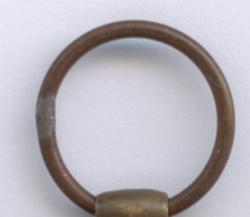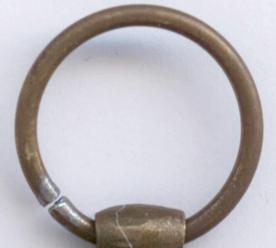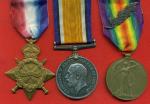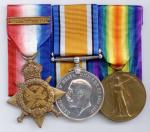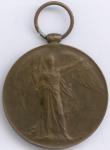-
Posts
552 -
Joined
-
Last visited
-
Days Won
2
Content Type
Profiles
Forums
Blogs
Gallery
Events
Store
Everything posted by Gunner 1
-

British Victory Medals
Gunner 1 replied to Kev in Deva's topic in Inter-Allied Victory Medals of the Great War
Bill wrote: "Will you be publishing the text of your talk at the Atlanta Convention?" Bill: Some portions of my talk have already been published in two articles in the OMRS Journal. I will probably publish the new material in that journal or in JOMSA. Regards, Gunner 1 -

British Victory Medals
Gunner 1 replied to Kev in Deva's topic in Inter-Allied Victory Medals of the Great War
I should have mentioned in my last post that if any of you are attending the Orders and Medals Society of America Convention in Atlanta in August I am giving a seminar talk on the Great War British Victory Medal which will discuss all aspects of the two (or is now three) types and statistical information on the numbers awarded based on an analysis of the newly released Great War medal rolls on Ancestry. Gunner 1 -

British Victory Medals
Gunner 1 replied to Kev in Deva's topic in Inter-Allied Victory Medals of the Great War
The reissued VM and BWM illustrated in the post you cite on the Great War Forum are as poorly designed as many of the so-called 'replacement' medals for sale on eBay! I wonder who supplies them to the MoD? -

British Victory Medals
Gunner 1 replied to Kev in Deva's topic in Inter-Allied Victory Medals of the Great War
Bilco: Two things to note about the VM you illustrate in the post above: 1. The obverse appears much darker has less detail than the reverse. 2. The high spots on the reverse (letters in the wording and berries on the wreath) and on a portion of the rear of the suspension are bright gilt. This makes me think that the medal is a Type II VM that has been subjected to fire or some type of chemical or has been buried in the ground for some time. Gunner 1 -

British Victory Medals
Gunner 1 replied to Kev in Deva's topic in Inter-Allied Victory Medals of the Great War
My opinion is that you cannot always tell a Type I VM on just one feature alone, such as the soldered barrel suspension (maybe it was soldered after being damaged or broken), but most use all of the features together. As you indicate, your "guaranteed" Type I that has an issue date in 1920, has an un-soldered suspension ring and that, or one that is soldered with very noticeable silver solder, is what I have seen on the Type I VMs that I have examined. The solder on the suspension ring of the VM you illustrate above does not have that characteristic. -

British Victory Medals
Gunner 1 replied to Kev in Deva's topic in Inter-Allied Victory Medals of the Great War
I am not convinced that it is a Type I VM. The soldering on the suspension ring is the same color as the suspension ring and blends with it - this is a characteristic of the Type II VM. Type I VMs suspension rings are either un-soldered or are soldered with a grayish-white solder. -

British Victory Medals
Gunner 1 replied to Kev in Deva's topic in Inter-Allied Victory Medals of the Great War
Bilco: Would it be possible for you to post a scan of the soldering (or lack thereof) on the suspension ring? -

Italy Italian WW1 aviator -- help with ID medals
Gunner 1 replied to Luftmensch's topic in Southern European & Balkan States
Yes, but in the illustrated ribbon bar, aren't the stars are on the War Medal not the War Merit Cross? -

Italy Italian WW1 aviator -- help with ID medals
Gunner 1 replied to Luftmensch's topic in Southern European & Balkan States
Gordon Criag wrote: 'The two stars indicate that the War Merit Medal was awarded twice.' According to The Medals, Decorations & Orders of the Great War 1914-1918 by Alex A. Purves. The medal with the two stars is the War Medal 1915-1918 and the stars on the ribbon do not indicate additional awards of the medal, but rather possession of two of the nine campaign bars issued for the medal. -

Italy Italian WW1 aviator -- help with ID medals
Gunner 1 replied to Luftmensch's topic in Southern European & Balkan States
My guesses: Top row: (left to right): Chevalier, Order of the Crown; Aeronautical Valor Medal (silver?); War Cross Bottom row (left to right): War Medal with two stars; United Italy Medal. -

British Victory Medals
Gunner 1 replied to Kev in Deva's topic in Inter-Allied Victory Medals of the Great War
Herman: Harold Williamson in his The Great War Medal Collectors Companion illustrates what he calls an original MiD emblem and two photos of what he refers to as 'Good Copy MID emblems' but other than mentioning that 'the originals are of high quality' he gives no documentation or sources for his information; nor does he indicated how to tell the originals from the copies. Jim Condon in his Mentioned in Despatches: the Evolution of Certificates and Emblems for British Mentions in Despatches states that four different contractors produced the 150,000 emblems required: Wm Dowler & Sons Ltd (30,000 small emblems) J.R. Gaunt & Sons Ltd (57,000 small emblems) Smith & Wright Ltd (25,000 large emblems) Firmin & Sons Ltd (13,000 each of small and large emblems) but these manufacturers only account for 138,000 emblems rather than the 150,000 total he quotes. According to Condon the large-size oak leaf emblem was 35mm long and was produced in prong-fixing and sew-on types. He estimates that 141,080 MiDs were awarded during the Great War. If 141,080 MiDs were issued during the Great War and each person mentioned received a large emblem for placement on the medal ribbon and a smaller emblem for the service ribbon then at least 282,160 emblems would need to have been produced - almost double the 150,000 Condon indicates that are documented as being produced. Then there are all those who lost there emblems and would need replacements. Gunner 1 -

British Victory Medals
Gunner 1 replied to Kev in Deva's topic in Inter-Allied Victory Medals of the Great War
It does not appear to be an 'official' MiD emblem but it is the one that was on the group when I purchased it so left it on. Must say that the emblem looks completely different on the actual VM than it does in the photo - the lighting for the photo appears to have extensuated the lines in the emblem. -

British Victory Medals
Gunner 1 replied to Kev in Deva's topic in Inter-Allied Victory Medals of the Great War
-

British Victory Medals
Gunner 1 replied to Kev in Deva's topic in Inter-Allied Victory Medals of the Great War
1915-1915 Star trio with Type I Victory Medal to Major Hugh Frederick Scudamore, RFA who was twice mentioned in despatches and three times wounded while serving with 91st Brigade, RFA. -

British Victory Medals
Gunner 1 replied to Kev in Deva's topic in Inter-Allied Victory Medals of the Great War
Photo of the 1914 Star/Bar trio with Type I Victory Medal to 2nd Lieut. Thomas J. Gough, RFA that I mentioned in the previous post. -
From The Army Gradation List February 1966; The Army List, Part III, Biographical, 1974I: and The Army List, Part II, Officers in Receipt of Retired Pay, 1982: Major John Terence Della Durbin, MBE Born 2 Apr 28 Served in the ranks for 1 year and 30 days Regular Army Emergency Commission as 2nd Lieut. from 30 Nov 46 to 31 Jul 49 Lieut. 5 Dec 47 Temp. Captain from 12 Nov 48 to 12 Sept 49 Short Service Commission as a Lieut. from 1 Aug 49 (with date of rank of 30 Nov 47) Temp. Captain from 2 Jun 54 to 2 Apr 55 Reserve of Officers 26 Aug 55 Regular Commission in The Gordons as Lieutenant, 18 Jun 56 (with date of rank of 2 Apr 49) Captain, Gordons, 18 Jun 56 (with date of rank of 2 Apr 55) Temp. Major from 27 Oct 59 to 6 Aug 60 Major, Gordons, 2 Apr 62 Deputy Asst. QM General, Q1 from 30 Oct 69 to 1 Sep 71 Retired as Major, Gordons, on 10 Oct 76 Regards, Gunner 1
-
Not an answer to the number question but those of you who collect US Silver Stars and are not OMSA members might like to know that the July-August 2014 issue of the Journal of the Orders and Medals Society of America had a 16-page article by Fred Borch titled "Army Silver Stars for World War I and II, and Korea: A Study of Official Naming. It contains 63 illustrations of the various styles of naming on the Silver Star during that period. In the upcoming January-February 2015 issue of the same Journal (will be out the last week of January) there is an 11-page article on "The United States Silver Star to Belgians for Gallantry in Action during World War II" with a list of recipients and illustrations of the naming on these Silver Stars. Regards, Gunner 1
-

British Victory Medals
Gunner 1 replied to Kev in Deva's topic in Inter-Allied Victory Medals of the Great War
Just purchased a 1914 Star trio with Type I Victory Medal to a 2nd Lieutenant, RFA (formerly BSM, RFA) from the online list of a well-known UK dealer. VM issued on 16 October 1920. There was no mention of the Type I VM in the dealer's description of the lot. He was wounded at Pilkem, Belgium (north of Ypres) on 23 October 1914 while serving with 43rd Brigade, RFA. The group also includes his officers' papers. Will provide some photos as soon as the group arrives in the mail. Gunner 1 -

British Victory Medals
Gunner 1 replied to Kev in Deva's topic in Inter-Allied Victory Medals of the Great War
The suspension of the medal and the date of issue of the medal on the MIC indicate that it is a Type I VM, but it is much lighter than the normal Type I. The extensive strengthening of the suspension and the lightness of color may well be due to a 'refurbishing' of the medal prior to sending it to the recipient. My information indicates that he was serving with the Lahore Division Ammunition Column, RFA in 1917. -

British Victory Medals
Gunner 1 replied to Kev in Deva's topic in Inter-Allied Victory Medals of the Great War
MIC for other ranks usually do not show the issue date (most officer's MICs do) but a copy of the medal roll for the Victory Medal for Cpl Hodgson might indicated the date of issue. -

British Victory Medals
Gunner 1 replied to Kev in Deva's topic in Inter-Allied Victory Medals of the Great War
As I mentioned in an earlier post, I have a second article on the Type I Victory Medal being published in the September 2014 issue of the Journal of the Orders and Medals Research Society. In that article I discuss the differences between the Type I and Type II VMs and using the 27 Type I VMs that I have so far identified (12 of which are in my collection) look at the distribution of the medals in terms of regiment and ranks to which they were issued. Fifteen were issued to the Royal Artillery, two to the Dragoon Guards, and two to the QAIMNS, with the rest to various infantry regiments (I did not know about the Labour Corps awards mentioned above at the time of writing the article about a year ago). You will have to read the article for the rest of the information but suffice it to say that the vast majority of the 27 Type I VMs were to persons awarded a 1914 Star. Regards, Gunner 1 -

British Victory Medals
Gunner 1 replied to Kev in Deva's topic in Inter-Allied Victory Medals of the Great War
Bilco: Looks like a Type 1 to me and the date of the receipt seems to reinforce that assumptiion. For those of you who are members of the OMRS, I have a follow-up article on the British Type I Victory Medal being published in the September 2014 issue of their Journal. -

British Victory Medals
Gunner 1 replied to Kev in Deva's topic in Inter-Allied Victory Medals of the Great War
The photo below is the VM to 2nd Lt. Hornell that was for sale on eBay. It has all the characteristics of a Type I VM: dark-chocolate color; rough, sand-blasted surface; the engraver's name showing lack of detail; suspension soldered to planchet; unsoldered suspension ring. -

British Victory Medals
Gunner 1 replied to Kev in Deva's topic in Inter-Allied Victory Medals of the Great War
davidck and Bilco: What makes the suspension different is that it in the Type I it was produced separately from the planchet and then soldered to the planchet; in the Type II the suspension is part of the planchet. There is no doubt in my mind that the VM in eBay item 191029335680 is a Type I as it has all the characteristics of a Type I and the recipients Medal Index Card indicates that the VM was issued to him on 3 November 1920 (the Type II VM was not approved or produced until January 1921). I was the winning bidder on that lot and expect to receive it in the mail in the next few days. Once it arrives I will post some scans of the medal and the suspension.


